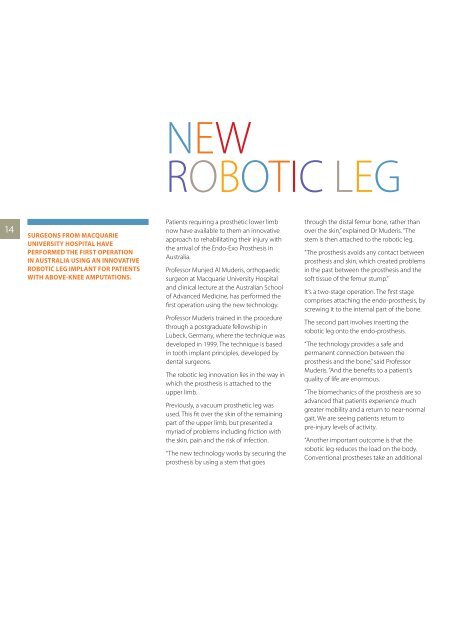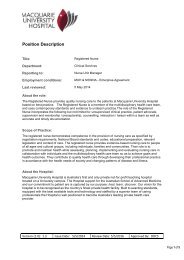reconstructive plastic surgery - Macquarie University Hospital
reconstructive plastic surgery - Macquarie University Hospital
reconstructive plastic surgery - Macquarie University Hospital
You also want an ePaper? Increase the reach of your titles
YUMPU automatically turns print PDFs into web optimized ePapers that Google loves.
14<br />
SuRGEOnS fROM MACquARiE<br />
uniVERSiTY HOSPiTAl HAVE<br />
PERfORMED THE fiRST OPERATiOn<br />
in AuSTRAliA uSinG An innOVATiVE<br />
RObOTiC lEG iMPlAnT fOR PATiEnTS<br />
wiTH AbOVE-knEE AMPuTATiOnS.<br />
NeW<br />
RoBoTIC leG<br />
Patients requiring a prosthetic lower limb<br />
now have available to them an innovative<br />
approach to rehabilitating their injury with<br />
the arrival of the endo-exo Prosthesis in<br />
Australia.<br />
Professor Munjed Al Muderis, orthopaedic<br />
surgeon at <strong>Macquarie</strong> <strong>University</strong> <strong>Hospital</strong><br />
and clinical lecture at the Australian School<br />
of Advanced Medicine, has performed the<br />
first operation using the new technology.<br />
Professor Muderis trained in the procedure<br />
through a postgraduate fellowship in<br />
lubeck, Germany, where the technique was<br />
developed in 1999. The technique is based<br />
in tooth implant principles, developed by<br />
dental surgeons.<br />
The robotic leg innovation lies in the way in<br />
which the prosthesis is attached to the<br />
upper limb.<br />
Previously, a vacuum prosthetic leg was<br />
used. This fit over the skin of the remaining<br />
part of the upper limb, but presented a<br />
myriad of problems including friction with<br />
the skin, pain and the risk of infection.<br />
“The new technology works by securing the<br />
prosthesis by using a stem that goes<br />
through the distal femur bone, rather than<br />
over the skin,” explained Dr Muderis. “The<br />
stem is then attached to the robotic leg.<br />
“The prosthesis avoids any contact between<br />
prosthesis and skin, which created problems<br />
in the past between the prosthesis and the<br />
soft tissue of the femur stump.”<br />
It’s a two-stage operation. The first stage<br />
comprises attaching the endo-prosthesis, by<br />
screwing it to the internal part of the bone.<br />
The second part involves inserting the<br />
robotic leg onto the endo-prosthesis.<br />
“The technology provides a safe and<br />
permanent connection between the<br />
prosthesis and the bone,” said Professor<br />
Muderis. “And the benefits to a patient’s<br />
quality of life are enormous.<br />
“The biomechanics of the prosthesis are so<br />
advanced that patients experience much<br />
greater mobility and a return to near-normal<br />
gait. We are seeing patients return to<br />
pre-injury levels of activity.<br />
“Another important outcome is that the<br />
robotic leg reduces the load on the body.<br />
Conventional prostheses take an additional

















